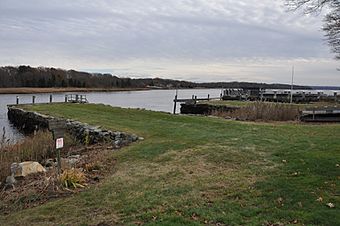Dighton Wharves Historic District facts for kids
Quick facts for kids |
|
|
Dighton Wharves Historic District
|
|

(From Left to Right: The Spooner Wharf, The Andrews Wharf, and The Perry Wharf). The Andrews and Spooner Wharves remain as they were when constructed, while the Perry Wharf was renovated to its present form in the early 2000s.
|
|
| Location | Dighton, Massachusetts |
|---|---|
| Area | 5.5 acres (2.2 ha) |
| Built | 1730 |
| Architect | Elkanah Andrews, Darius Perry |
| Architectural style | Georgian, Greek Revival, Cape Cod |
| NRHP reference No. | 97000725 |
| Added to NRHP | July 17, 1997 |
The Dighton Wharves Historic District is a special area in Dighton, Massachusetts. It's known for its old buildings and docks. This district was once a busy port on the Taunton River in the 1700s and 1800s. It includes three wharves (docks) and four houses that were built a long time ago. This historic area was added to the National Register of Historic Places in 1997.
Contents
What is the Dighton Wharves Historic District?
The town of Dighton is on the west side of the Taunton River in Bristol County, Massachusetts. European settlers first came here in the 1670s. Dighton became a town in 1712. In the 1700s, it became an important place for ships. Big ships could not go further up the river. So, shipyards and wharves were built along the riverbanks.
This historic district is in the south-central part of Dighton's waterfront. It's just south of Muddy Cove. There used to be a ferry service here too. Over time, Dighton became less important for shipping. This was because Fall River became a bigger port for deep-water ships.
Historic Houses and Wharves
The district runs along Pleasant Street, which is close to the river. It has four old houses on the west side of the road. On the east side, three wharves stick out into the river.
The Perry House and Wharf
At the south end of the district is the house and wharf of Darius Perry. He was a ship's captain who sailed to the West Indies. His house was built around 1720. It's a 1-1/2 story Cape Cod style house. It has been made bigger over the years, but its original shape is still clear. The inside of the house has been kept as it was. His wharf is about 30 feet (9.1 m) wide and just as long. It was built by hand using stones without mortar. The other two wharves were built this way too.
The Eddy House
North of Perry's house is the Eddy House (2320 Pleasant Street). This is a 3-story Georgian style house. It was built around 1730. Around 1870, it got a new look with Italianate styling. Elkanah Andrews built this house. He was another merchant who traded with the West Indies. He built this house for himself and two others for his sons. Darius Perry bought the Eddy House in 1825 for his daughter and her husband, Captain William Eddy.
A guest house used to be behind the Eddy House from the 1870s to the mid-1900s. It was later taken apart and moved to Brewster. In the early 1900s, the Eddys used the guest house as a hall for events. They also had a farm with animals in a large barn. People would come to visit the Eddy House by train, trolley, ferry, or stagecoach. Since ship captains built these houses, they used many shipbuilding methods. For example, large wooden pegs were used instead of steel bolts. The Eddy House is at the highest point of the district. It has kept over 240 years of history safe.
Andrews' Own House and Wharves
The next house (2308 Pleasant Street) was Elkanah Andrews' own home. It was built around 1740. It's a large 2-1/2 story building. Around 1830, it was updated with a Greek Revival style. Andrews likely built the Spooner Wharf, which is across from his house. He also built the Andrews Wharf to its south. The Andrews Wharf is like Perry's wharf. The Spooner Wharf is the longest of the three, at 70 feet (21 m). In 1803, Captain James Spooner bought Andrews' house. He was a rich ship's captain from Rhode Island.
The Old Customs House
At the north end of the district is the "Old Customs House." Andrews built this house for his son Thomas around 1770. From 1809 to 1834, the Williams family owned it. They worked as local customs collectors. They even had a small customs office in one of the back rooms of the house.
The Molasses Affair
In 1765, something important happened at the Dighton wharves. It was called the "Molasses Affair." This was a protest against British taxes on molasses. It was similar to the more famous Boston Tea Party.
At that time, the British government had a tax law called the Molasses Act. A local ship told British officials it had 63 barrels of molasses. But the ship actually had twice that many! The customs official ordered the ship's cargo to be held. He then left to get help from Newport. While he was gone, about forty local men covered their faces to hide who they were. They stole the extra molasses. Then, they ran the ship onto the shore and drilled holes in its bottom. This was their way of protesting the British tax rules.



